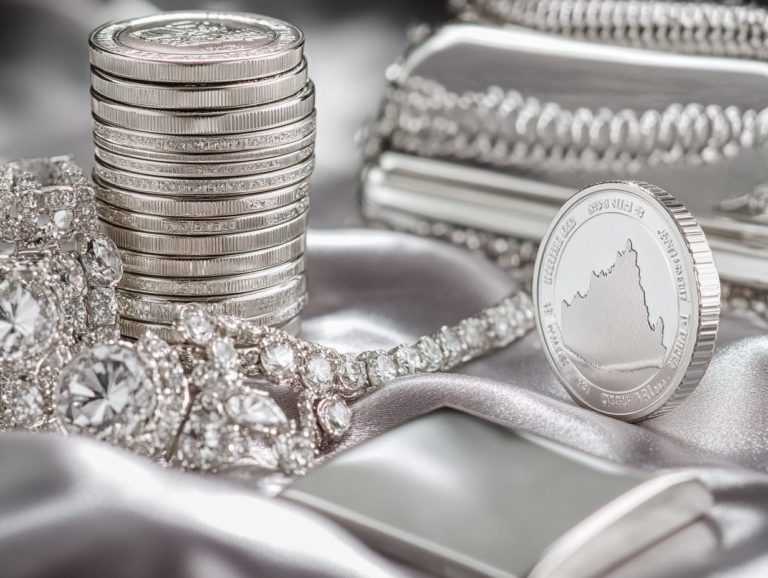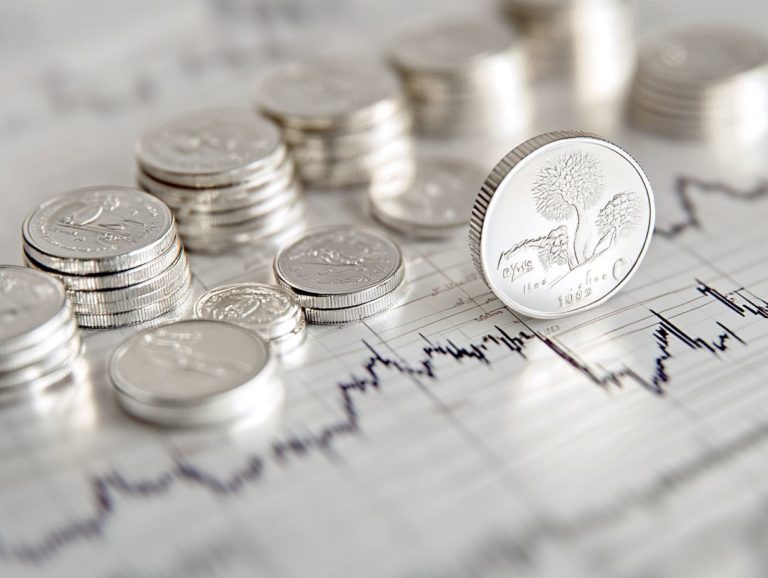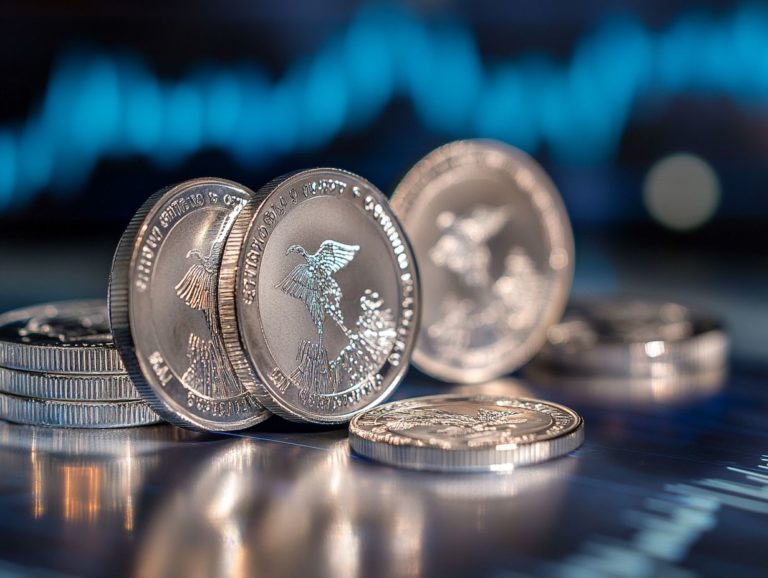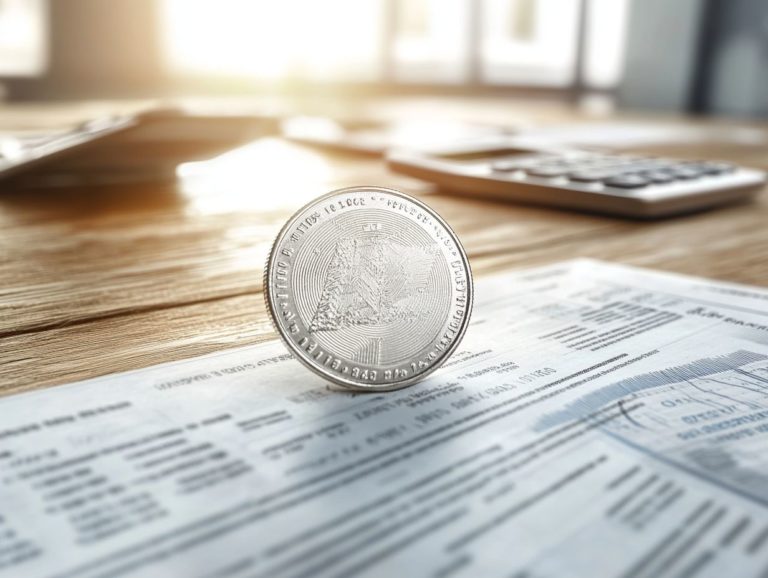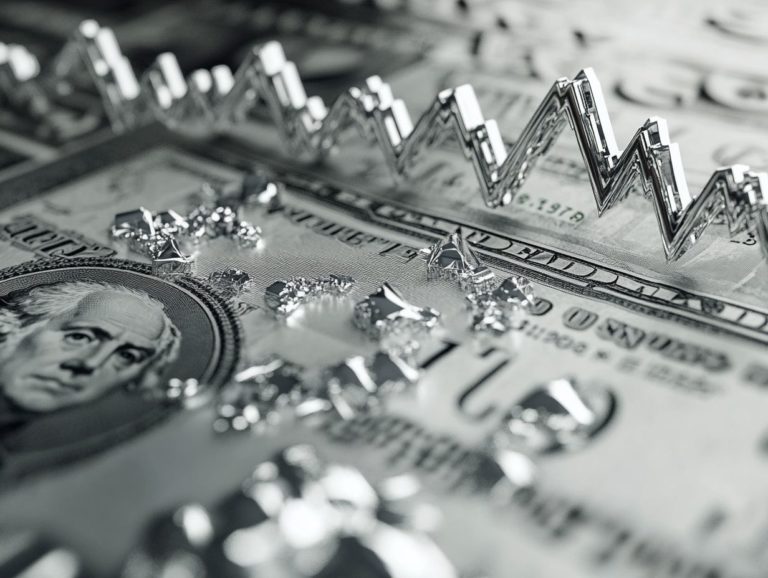The Top Silver Investment Strategies Explained
Investing in silver is becoming a popular choice among savvy investors as it serves as a smart hedge against inflation and a strategic way to diversify your investment portfolio.
This article delves into the types of silver investments, comparing the merits of physical silver to paper silver while highlighting crucial factors to consider before making your move.
You ll explore market trends, potential risks, and effective strategies for both long-term and short-term investments. You ll also find valuable tips for making informed decisions and unlocking your silver investment potential.
Explore the ways silver can elevate your financial future!
Contents
- Key Takeaways:
- Why Invest in Silver?
- Types of Silver Investments
- Factors to Consider Before Investing in Silver
- Effective Strategies for Silver Investing
- Tips for Successful Silver Investing
- Frequently Asked Questions
- What are the top silver investment strategies?
- How does buying physical silver work as an investment strategy?
- What are silver stocks and ETFs, and how can they be used as an investment strategy?
- What is a silver certificate, and how does it serve as an investment strategy?
- What is silver futures trading, and how can it be utilized as an investment strategy?
- How can investing in silver mining companies be a profitable investment strategy?
Key Takeaways:
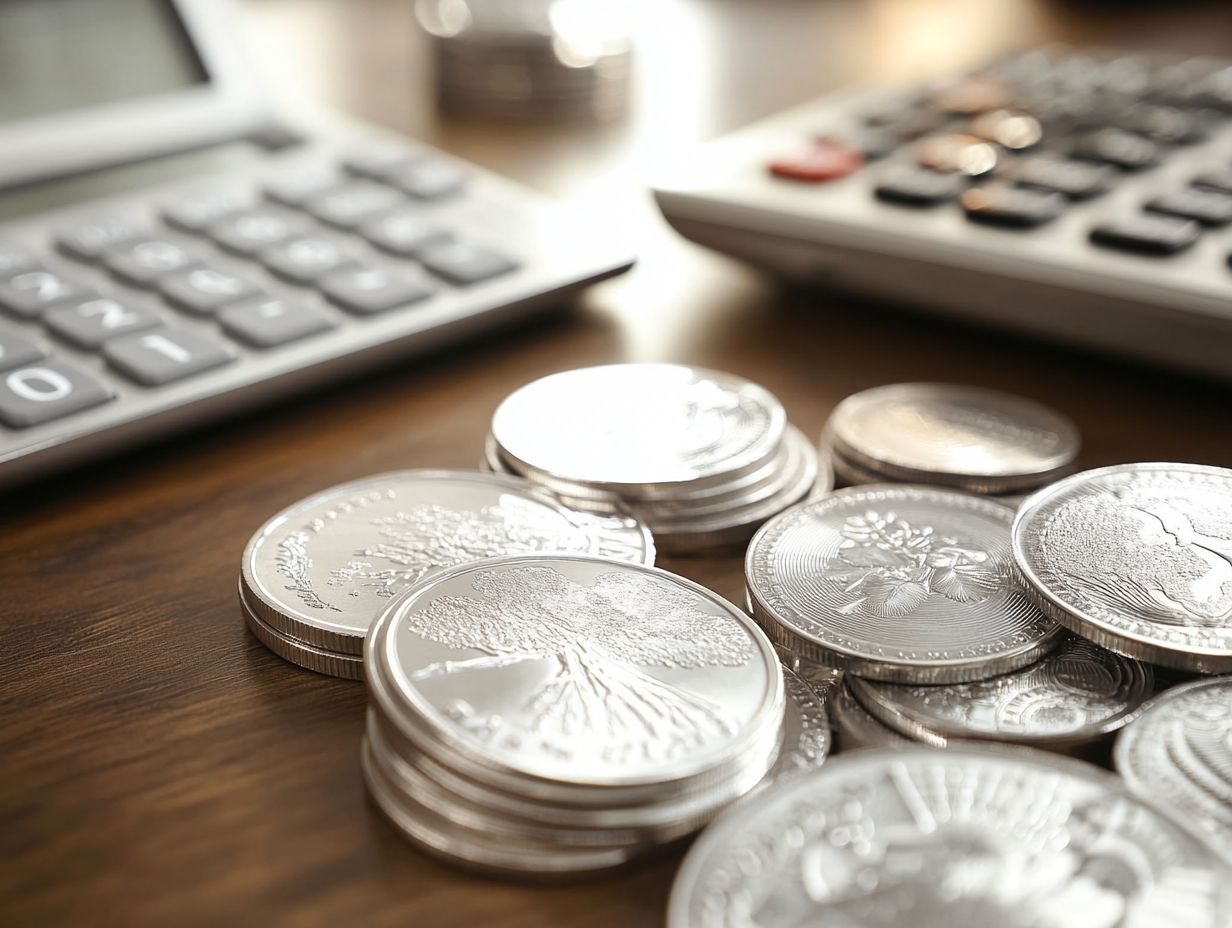
- Diversification is key when it comes to silver investments. Consider including both physical and paper silver in your portfolio to minimize risk.
- Timing is crucial in silver investments. Keep an eye on market trends and potential risks to make informed decisions about when to buy and sell.
- Conduct thorough research and work with a financial advisor to ensure successful silver investing. This will help you make strategic decisions to maximize your returns.
Why Invest in Silver?
Investing in silver is a savvy strategy for anyone looking to diversify their portfolio and hedge against inflation, especially given the current market volatility and shifting economic landscape.
As a precious metal with a strong history of maintaining value, silver presents a unique opportunity for investors, offering both physical and financial assets.
With high-profile investors like Warren Buffett showing interest and expanding liquid markets, it s essential to understand the benefits and risks associated with silver investments to make informed financial choices.
Silver’s historical role as currency and a store of wealth adds to its allure in today s market. Unlike more erratic assets, silver tends to hold its value during economic downturns, acting as a bulwark for those focused on safeguarding their investment goals.
In a landscape marked by rising inflation rates and unpredictable global markets, silver stands out as a compelling option for achieving long-term financial stability. Incorporating silver into your investment strategy can enhance security and offer potential for capital appreciation the increase in the value of your investment over time making it a critical component of a well-rounded investment approach.
Types of Silver Investments
When considering an investment in silver, you have various options, each presenting its own benefits and risks shaped by market dynamics.
You can invest in tangible assets like physical silver think iconic coins such as the American Eagle or Canadian Maple Leaf or you might prefer paper assets like ETFs and silver futures, which provide exposure to silver without the hassle of physical storage.
Understanding these choices is essential for developing effective investment strategies that resonate with your unique financial goals.
Physical Silver vs. Paper Silver
You often find yourself weighing the choice between physical silver and paper silver, each offering distinct advantages and inherent risks. Physical silver like coins and bullion provides tangible value and acts as a reliable store of wealth, especially during economic uncertainty.
On the other hand, paper silver, represented by investments like ETFs, delivers convenience and liquidity, allowing for easier navigation in a fast-paced market.
Evaluating how quickly you can sell each option is crucial. While physical silver may take time to sell and requires secure storage to guard against theft and degradation, paper silver generally allows for quicker transactions through online platforms and brokerage accounts.
Market risks, such as volatility, can still impact the value of paper silver, making it important to stay informed about market trends.
Your strategies may vary significantly based on your risk tolerance. Some individuals prefer the intrinsic security that physical assets provide, while others lean towards the flexibility and ease of management that paper investments offer. Ultimately, it’s about finding the balance that aligns with your financial goals.
Act now to understand market trends before investing!
Factors to Consider Before Investing in Silver
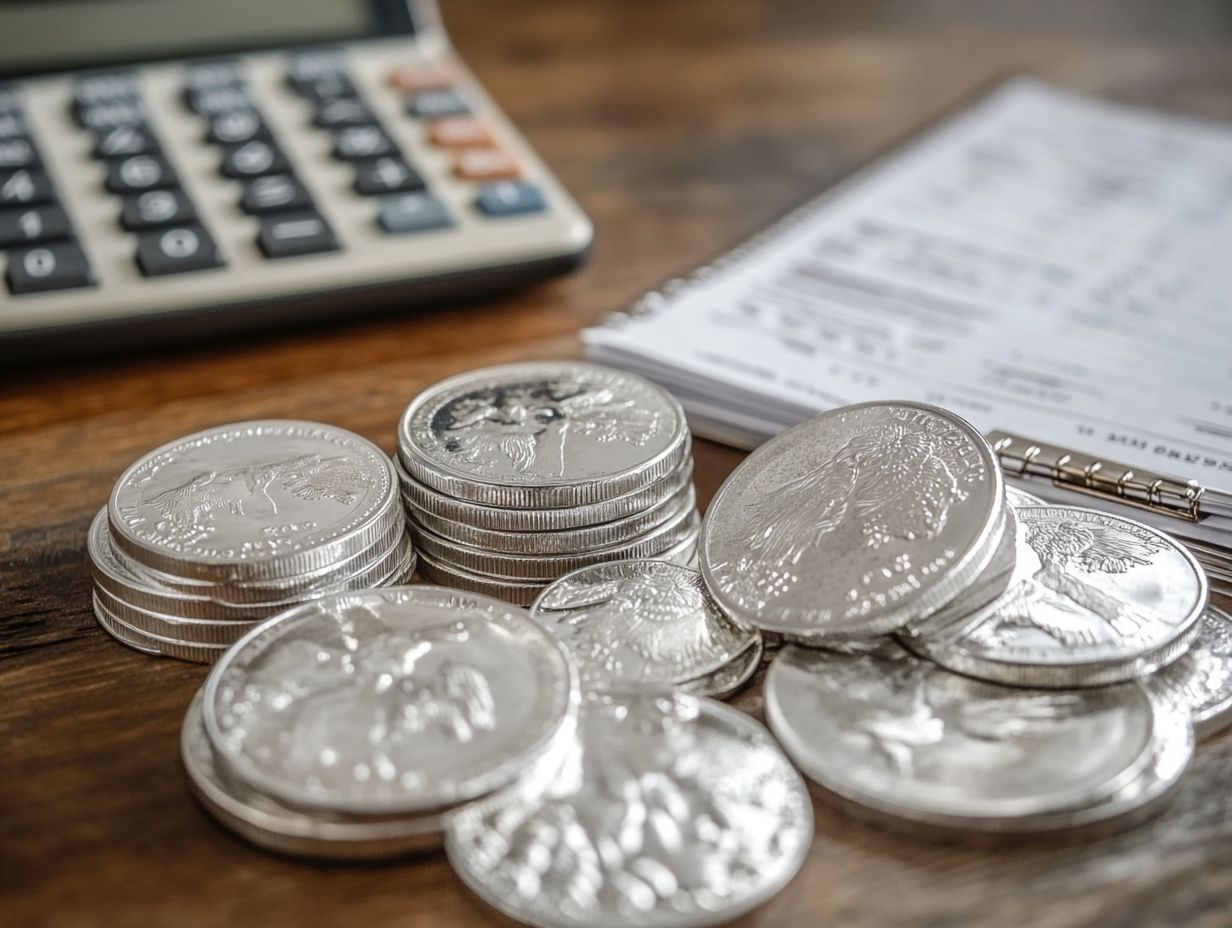
Before you dive into silver investments, it s vital to consider several key factors that could significantly impact your financial decisions and long-term success in the market.
Understanding market dynamics is thrilling and essential for your investment success! Trends in inflation and interest rates play a crucial role in evaluating the potential risks and rewards that silver can offer as an investment. Being aware of the broader economic landscape will enable you to make informed choices that align with your unique investment objectives.
Understanding the Market: Trends and Risks Ahead!
The silver market is shaped by a myriad of trends and risks that you should analyze carefully before investing. Market price fluctuations, driven by inflation and global economic conditions, can greatly affect your investment strategies and overall returns. By understanding these dynamics, you can better anticipate challenges and seize opportunities within the precious metals market.
Recent data shows a significant increase in silver demand, especially in industrial applications and the renewable energy sectors. This creates a balancing act between growth and vulnerability. Geopolitical tensions, such as trade disputes and conflicts, often amplify market volatility, so staying vigilant is crucial.
The relationship between rising industrial usage and speculative investments creates a complex landscape ripe for price surges. You must also be cautious of market corrections that can arise from price overextensions or shifts in monetary policy. A well-rounded strategy will be essential for successfully navigating these unpredictable waters.
Effective Strategies for Silver Investing
Successful silver investing relies on implementing effective strategies that consider market dynamics and your unique financial goals.
Diversification is a crucial principle that helps mitigate risks. By incorporating silver alongside other assets, you can achieve a well-balanced portfolio. Start diversifying your portfolio today to safeguard your investments!
Understanding market timing can enhance your returns. This enables you to capitalize on price fluctuations and economic trends that influence the silver market.
Crafting Your Silver Investment Strategy
Diversification and timing are essential ingredients in creating your silver investment strategy. They allow you to effectively manage risk while maximizing opportunities. By diversifying your portfolio with a mix of assets like silver coins, ETFs, and other precious metals, you can create a buffer against market volatility.
It s important to know when to enter or exit the market based on current dynamics. This knowledge will enable you to make more strategic financial decisions.
Consider incorporating various types of silver investments that align with your financial goals and risk tolerance. For instance, silver mining stocks can provide exposure to the metal’s price fluctuations, while silver futures contracts may appeal to those seeking leveraged opportunities.
Monitoring economic indicators, geopolitical events, and industry trends is crucial for pinpointing optimal timing. Seasoned investors often recommend a consistent investment strategy where you invest a fixed amount regularly, regardless of the market price. This helps mitigate the effects of market fluctuations and build a robust portfolio.
By implementing a thoughtful approach to diversification and timing, you can significantly enhance your chances of achieving successful outcomes in your silver investments.
In Summary: By understanding market dynamics, employing diversification strategies, and being aware of market timing, you can optimize your silver investments and work towards a secure financial future.
Long-Term vs. Short-Term Investments
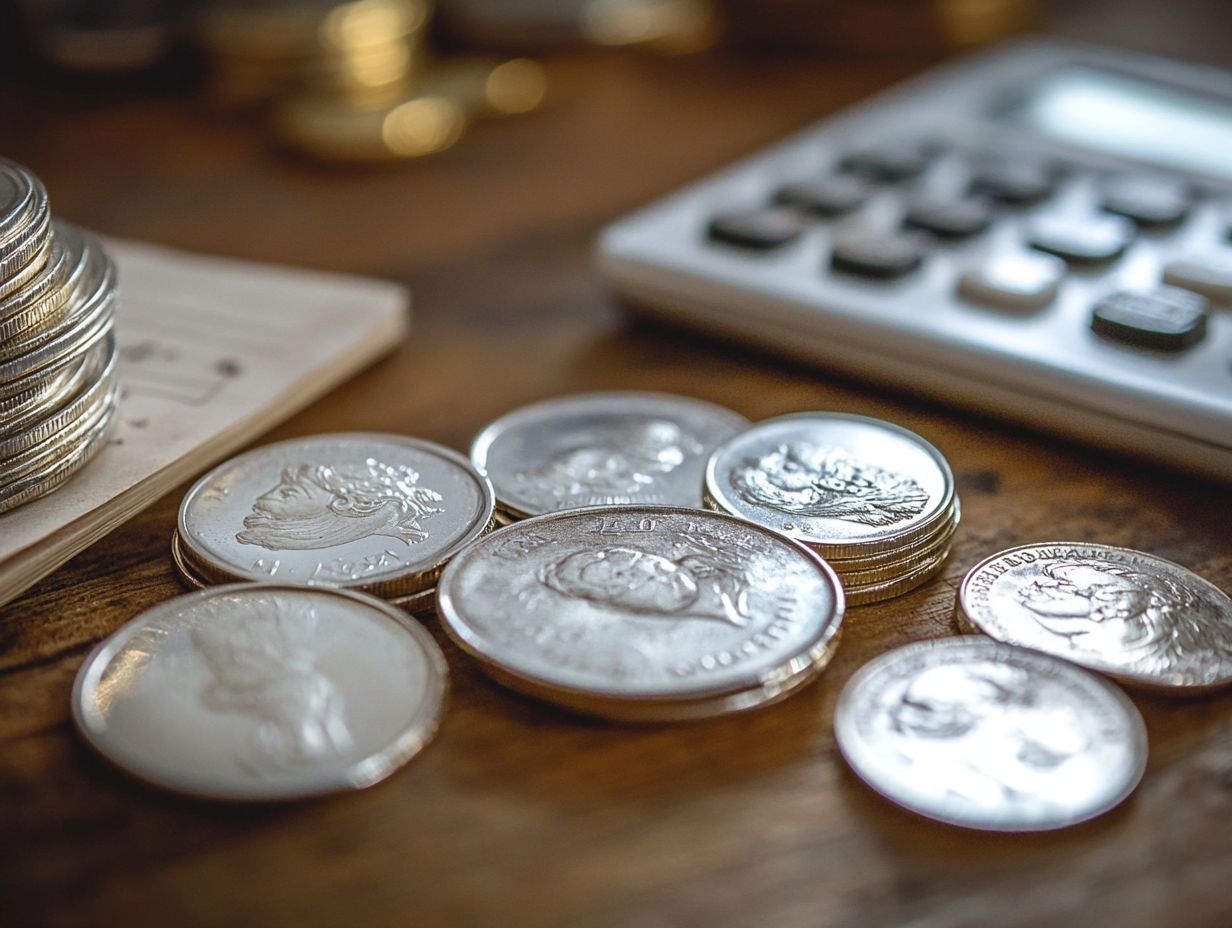
Choosing between long-term and short-term investments in silver requires you to evaluate your financial goals, the current market conditions, and the risks involved.
Long-term investments allow you to benefit from silver’s potential appreciation over time. In contrast, short-term strategies may focus on taking advantage of market price fluctuations for quicker profits.
Understanding the pros and cons of each approach is essential for crafting a personalized investment strategy in the silver market.
If you’re considering holding silver for the long haul, you can take advantage of historical trends that show the metal often appreciates during inflationary periods or times of economic uncertainty. This strategy requires patience and a steady hand to navigate market volatility.
If you prefer short-term investments, you might engage in trading using charts and data to predict price movements or news events. Your success here will heavily depend on your timing and the prevailing market sentiment.
However, short-term strategies can carry risks, including higher transaction costs and the potential for rapid losses during unfavorable price shifts. Striking a balance between these differing approaches allows you to customize your silver investments to align with your risk tolerance and financial aspirations.
Tips for Successful Silver Investing
Let s explore how to succeed in silver investing. It s important to arm yourself with the right knowledge and tools. Thorough research and due diligence are key.
Familiarize yourself with market trends, historical data, and various investment options available in the silver sector.
Collaborating with a qualified financial advisor can deepen your understanding and guide you toward smarter financial decisions.
Essential Research for Silver Investing
Conducting comprehensive research is vital if you’re looking to invest in silver. This groundwork equips you with the knowledge needed to navigate the market’s complexities.
By analyzing historical trends, current prices, and the performance of specific silver investments, you can make informed decisions that align with your overall investment strategies and financial goals.
Understanding key market indicators, such as supply and demand dynamics and economic conditions, is crucial for determining the best times to enter or exit the market.
Explore reputable resources and analytical tools that offer valuable insights into market forecasts. Engaging with expert opinions, participating in forums, and considering diversified investment options like physical silver, ETFs, or mining stocks can greatly enhance your portfolio.
Regularly review your findings and investment positions to make adjustments as market conditions evolve. A proactive research approach not only mitigates risks but also maximizes your potential for significant returns.
Start your silver investment journey today and unlock your financial potential!
Working with a Financial Advisor
Engaging with a financial advisor can truly elevate your approach to investing in silver. They offer invaluable insights into various investment strategies and potential risks. A qualified advisor will customize recommendations to align with your individual financial goals, guiding you through the complexities of the silver market.
This partnership fosters informed financial decisions and enables you to construct a diversified portfolio that includes silver and other precious metals.
By leveraging their expertise, your financial advisor helps you decipher market trends and anticipate fluctuations in silver prices. This ensures you have a comprehensive understanding of the landscape.
They aid in identifying optimal entry and exit points, ultimately maximizing your returns. You ll benefit from ongoing assessments that refine your investment strategies as your personal circumstances or market conditions evolve.
This makes your silver investment journey more secure and manageable. Their guidance is invaluable in pinpointing tax-efficient strategies, allowing you to retain more of your hard-earned gains over time.
Frequently Asked Questions
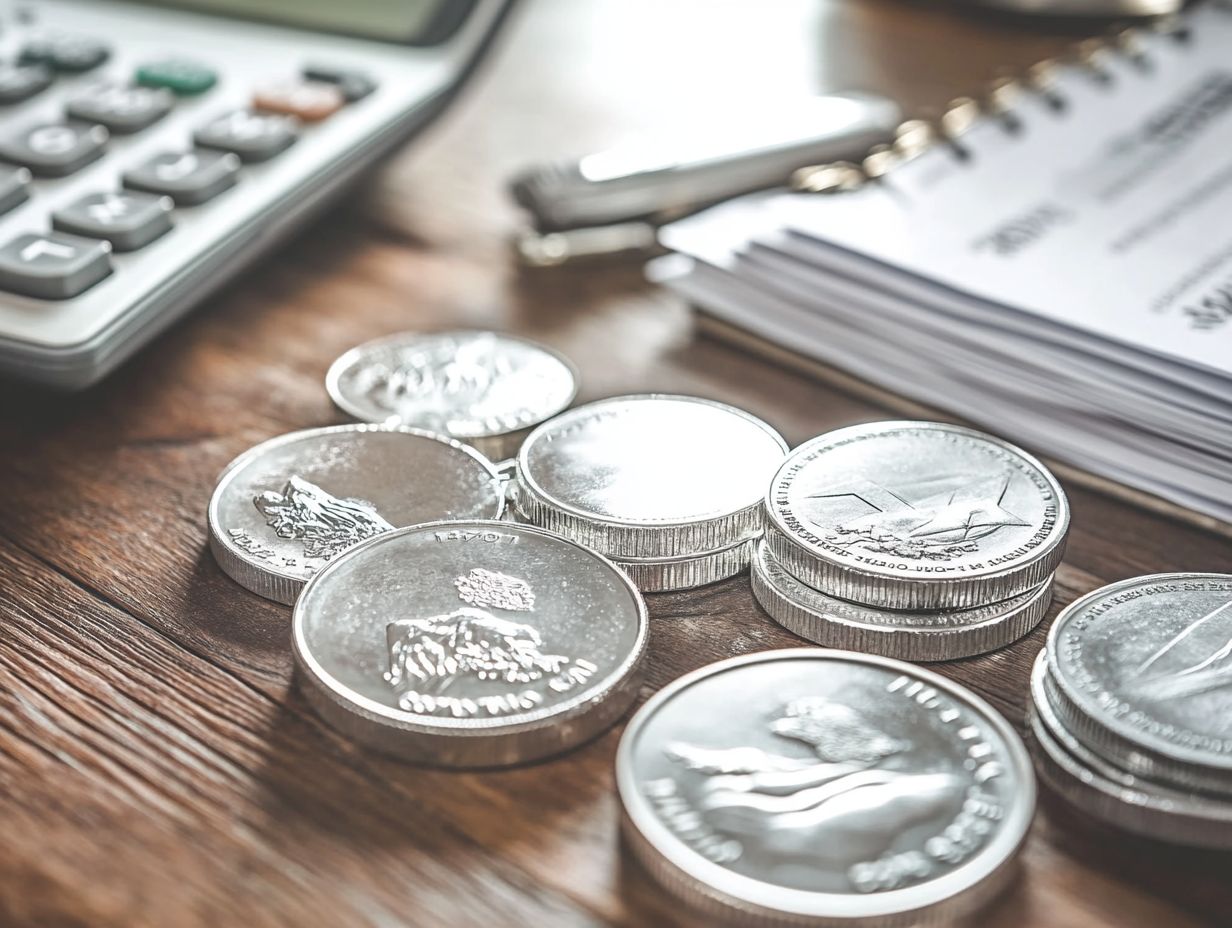
What are the top silver investment strategies?
- Buying physical silver
- Investing in silver stocks and ETFs (exchange-traded funds)
- Purchasing silver certificates
- Trading silver futures
- Investing in silver mining companies
How does buying physical silver work as an investment strategy?
Buying physical silver involves purchasing bars, coins, or bullion. This strategy allows for direct ownership of the silver, providing a hedge against inflation and currency devaluation.
What are silver stocks and ETFs, and how can they be used as an investment strategy?
Silver stocks and ETFs are investments in companies that mine or produce silver. This strategy offers diversification and the potential for higher returns, but it also carries more risk than buying physical silver.
What is a silver certificate, and how does it serve as an investment strategy?
A silver certificate represents ownership of a specific amount of physical silver. This strategy allows for ownership without the need for storage and can be easily traded on the market.
What is silver futures trading, and how can it be utilized as an investment strategy?
Silver futures are contracts to buy or sell silver at a predetermined price in the future. This strategy offers leverage and potential for high returns but also involves a high level of risk and requires market knowledge.
How can investing in silver mining companies be a profitable investment strategy?
Investing in silver mining companies involves purchasing stocks or shares of companies engaged in mining and producing silver. This strategy can expose you to the silver market and potential growth, though it also carries risks associated with the mining industry.
For more tailored advice, consider consulting a financial advisor or exploring various silver investment options.










